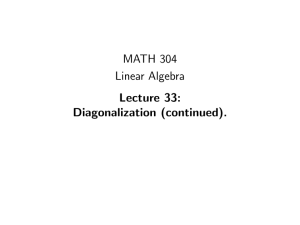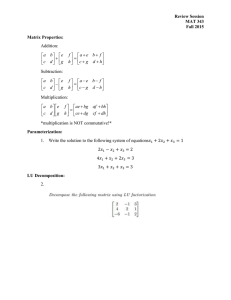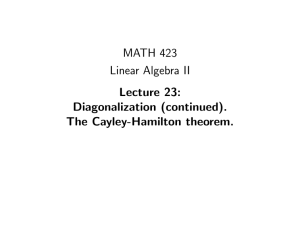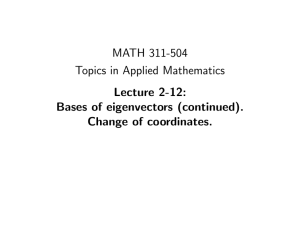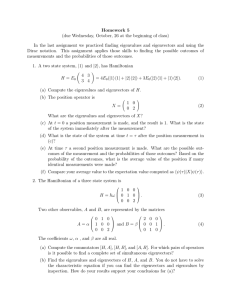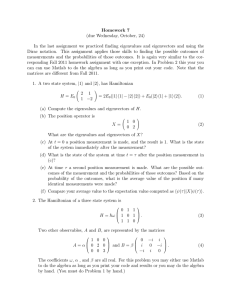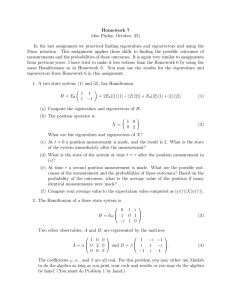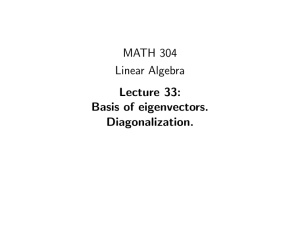MATH 304 Linear Algebra Lecture 33: Diagonalization (continued).
advertisement
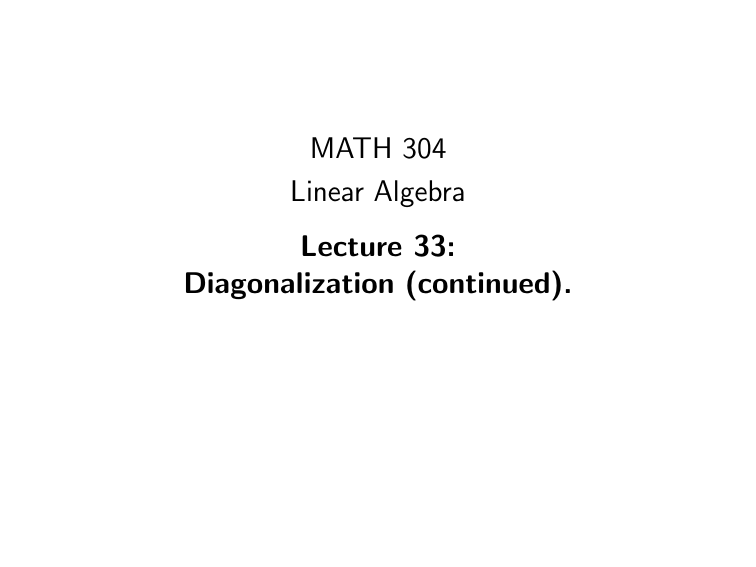
MATH 304
Linear Algebra
Lecture 33:
Diagonalization (continued).
Diagonalization
Let L be a linear operator on a finite-dimensional vector space
V . Then the following conditions are equivalent:
• the matrix of L with respect to some basis is diagonal;
• there exists a basis for V formed by eigenvectors of L.
The operator L is diagonalizable if it satisfies these
conditions.
Let A be an n×n matrix. Then the following conditions are
equivalent:
• A is the matrix of a diagonalizable operator;
• A is similar to a diagonal matrix, i.e., it is represented as
A = UBU −1 , where the matrix B is diagonal;
• there exists a basis for Rn formed by eigenvectors of A.
The matrix A is diagonalizable if it satisfies these conditions.
Otherwise A is called defective.
Theorem 1 If v1 , v2 , . . . , vk are eigenvectors of a linear
operator L associated with distinct eigenvalues λ1 , λ2 , . . . , λk ,
then v1 , v2 , . . . , vk are linearly independent.
Theorem 2 Let λ1 , λ2 , . . . , λk be distinct eigenvalues of a
linear operator L. For any 1 ≤ i ≤ k let Si be a basis for the
eigenspace associated with the eigenvalue λi . Then the union
S1 ∪ S2 ∪ · · · ∪ Sk is a linearly independent set.
Corollary Let A be an n×n matrix such that the
characteristic equation det(A − λI ) = 0 has n distinct real
roots. Then
(i) there exists a basis for Rn consisting of eigenvectors of A;
(ii) all eigenspaces of A are one-dimensional.
There are two obstructions to existence of a basis
consisting of eigenvectors. They are illustrated by
the following examples.
1 1
Example 1. A =
.
0 1
det(A − λI ) = (λ − 1)2. Hence λ = 1 is the only
eigenvalue. The associated eigenspace is the line
t(1, 0).
0 −1
Example 2. A =
.
1 0
det(A − λI ) = λ2 + 1.
=⇒ no real eigenvalues or eigenvectors
(However there are complex eigenvalues/eigenvectors.)
Matrix polynomials
Definition. Given an n-by-n matrix A, we let
A2 = AA, A3 = AAA, . . . , Ak = AA
. . . A}, . . .
| {z
Also, let A1 = A and A0 = In .
k times
Associativity of matrix multiplication implies that all powers
Ak are well defined and Aj Ak = Aj+k for all j, k ≥ 0. In
particular, all powers of A commute.
Definition. For any polynomial
p(x) = c0x m + c1x m−1 + · · · + cm−1 x + cm ,
let p(A) = c0 Am + c1 Am−1 + · · · + cm−1A + cm In .
Theorem If A = diag(a1 , a2, . . . , an ), then
p(A) = diag p(a1), p(a2), . . . , p(an ) .
Let A be an n-by-n matrix and suppose there exists
a basis v1 , . . . , vn for Rn consisting of eigenvectors
of A. That is, Avk = λk vk , where λk ∈ R.
Then A = UBU −1, where B = diag(λ1 , λ2, . . . , λn )
and U is a transition matrix whose columns are
vectors v1, v2, . . . , vn .
A2 = UBU −1UBU −1 = UB 2U −1,
A3 = A2 A = UB 2U −1UBU −1 = UB 3 U −1.
Likewise, An = UB n U −1 for any n ≥ 1.
I + 2A − 3A2 = UIU −1 + 2UBU −1 − 3UB 2U −1 =
= U(I + 2B − 3B 2)U −1.
Likewise, p(A) = Up(B)U −1 for any polynomial
p(x).
Problem. Diagonalize the matrix A =
Characteristic equation of A:
4 3
.
0 1
4−λ
3
= 0.
0
1−λ
(4 − λ)(1 − λ) = 0 =⇒ λ1 = 4, λ2 = 1.
Associated eigenvectors: v1 = (1, 0), v2 = (−1, 1).
Thus A = UBU −1, where
4 0
1 −1
B=
,
U=
.
0 1
0 1
Problem. Let A =
such that C 2 = A.
4 3
. Find a matrix C
0 1
We know that A = UBU −1 , where
1 −1
4 0
.
,
U=
B=
0 1
0
1
Suppose that D 2 = B for some matrix D. Let C = UDU −1 .
Then C 2 = UDU −1 UDU −1 = UD 2 U −1 = UBU −1 = A.
√
2 0
4 √0
=
.
We can take D =
0 1
0
1
1 −1
2 0
1 1
2 1
Then C =
=
.
0
1
0 1
0 1
0 1
Initial value problem for a system of linear ODEs:
(
dx
dt = 4x + 3y ,
x(0) = 1, y (0) = 1.
dy
=
y
,
dt
The system can be rewritten in vector form:
dv
4 3
x
= Av, where A =
, v=
.
0
1
y
dt
Matrix A is diagonalizable: A = UBU −1 , where
4 0
1 −1
B=
,
U=
.
0 1
0
1
w1
be coordinates of the vector v relative to the
Let w =
w2
basis v1 = (1, 0), v2 = (−1, 1) of eigenvectors of A. Then
v = Uw =⇒ w = U −1 v.
It follows that
dw
d
dv
= (U −1 v) = U −1
= U −1 Av = U −1 AUw.
dt
dt
dt
(
dw1
= 4w1 ,
dw
dt
Hence
= Bw ⇐⇒
dw2
dt
= w2 .
dt
General solution: w1 (t) = c1 e 4t , w2 (t) = c2 e t , where c1 , c2 ∈ R.
Initial condition:
w(0) = U
−1
v(0) =
1 −1
0
1
−1 1
1 1 1
2
=
=
.
1
0 1 1
1
Thus w1 (t) = 2e 4t , w2 (t) = e t . Then
4t 4t t x(t)
1 −1
2e −e
2e
.
= Uw(t) =
=
t
y (t)
et
0
1
e

